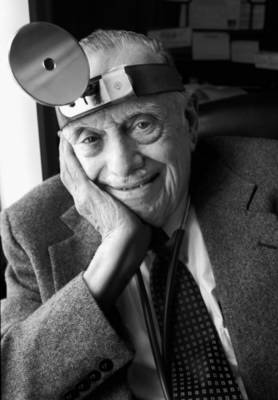
Dr. Carl Krill
Not all “memorable stories” posted here are by retired and forgotten reporters. Beacon reporter Tracy Wheeler on Feb 2 proved hat even a simple obituary about a memorable doctor can be "“a thing of beauty and a joy forever.”"
The first three graphs tell it all:
The one thing that patients remember most about Dr. Carl E. Krill was the round, mirrored reflector he wore on his forehead, long after most doctors had relegated the devices to antique status.
But among fellow doctors, the most memorable thing was Dr. Krill's ability to enter an examining room and walk out a few minutes later with a quick and accurate diagnosis, without a battery of tests.
Dr. Krill, a pediatrician, died Jan. 27 at the age of 101. After practicing medicine in the Akron area for more than 60 years, he retired in 1996, just two weeks short of his 93rd birthday.
The story cried out for the memorable photo which was unfortunately forgotten in the rush of things (that’'s news biz). The photo above did not appear with Tracy’'s story which was printed on page B1 on Wednesday, February 2, 2005. The story should have been printed on page A1.
Another reason it was good enough for A1 is explained by Tracy a few graphs later:
In 1941, Dr. Krill's handling of a local polio case brought him national fame. He didn't discover a cure, but, rather, a cause, after five Kenmore siblings had contracted bulbar polio, the most deadly form of the disease. When Dr. Krill learned that all five children had become ill about a week after having their tonsils removed, he saw a link.
Removing the tonsils, which are part of the body's immune system, had allowed the dormant polio virus to take over. Without the tonsillectomies, those children never would have suffered more than flulike symptoms. Instead, three of the five died.
The finding made national news publications, including the New York Times. It was published in the esteemed Journal of the American Medical Association. It even reached the White House, which sent the Kenmore family a letter of ``heartfelt sympathy'' from Franklin D. Roosevelt, who had been stricken by polio at age 39.
Dr. Krill's finding put the brakes on tonsillectomies, especially in the summer, when the polio virus was most active.
Click on the headline above to read Tracy'’s Memorable Story.
Blogger’s lament: It might have been better to just print Tracy’'s story out front and provide the link instead to my poor observations (that'’s the blog biz).

No comments:
Post a Comment